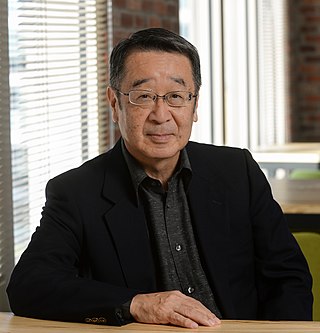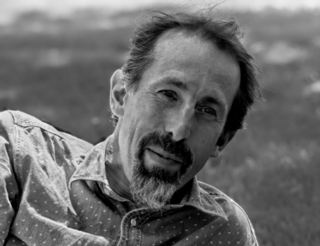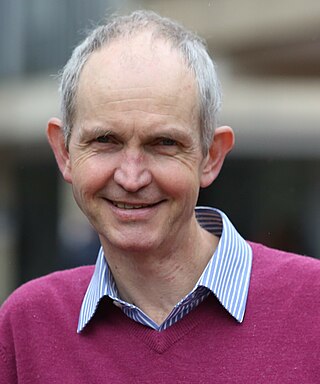Klaus Dodds is executive dean of the School of Life Sciences and Environment and professor of geopolitics at Royal Holloway, University of London. He is a visiting professor at the College of Europe in Natolin Warsaw Poland. He is a former editor of The Geographical Journal (2010-2015) and most recently Editor in Chief of Territory Politics Governance (2018-2024).

Alexey V. Kavokin is a Russian and French theoretical physicist and writer.

Yoshihisa Yamamoto is the director of Physics & Informatics Laboratories, NTT Research, Inc. He is also Professor (Emeritus) at Stanford University and National Institute of Informatics (Tokyo).
Donal Donat Conor Bradley is the Vice President for Research at King Abdullah University of Science and Technology (KAUST), Saudi Arabia. From 2015 until 2019, he was head of the Mathematical, Physical and Life Sciences Division of the University of Oxford and a Professor of Engineering Science and Physics at Jesus College, Oxford. From 2006 to 2015, he was the Lee-Lucas Professor of Experimental Physics at Imperial College London. He was the founding director of the Centre for Plastic Electronics and served as vice-provost for research at the college.
H. Pierre Noyes was an American theoretical physicist. He became a member of the faculty at the SLAC National Accelerator Laboratory at Stanford University in 1962. Noyes specialized in several areas of research, including the relativistic few-body problem in nuclear and particle physics.
Eric R. Bittner is a theoretical chemist, physicist, and distinguished professor of chemical physics at the University of Houston.
Professor Edward George Sydney Paige FRS, known as Ted Paige, was a British physicist and engineer. His main areas of research were semiconductor devices to improve radar, including work on surface acoustic waves, and optical techniques using programmable phase plates.
Arindam Ghosh is an Indian experimental condensed matter physicist and a Professor in the Department of Physics, Indian Institute of Science, Bangalore, India. He was awarded the Shanti Swarup Bhatnagar Prize for science and technology, the highest science award in India, for the year 2012 in physical sciences category. In 2020, he was awarded the Infosys Prize for Physical Science, the most prestigious award that recognizes achievements in science and research, in India.
Henning Sirringhaus is Hitachi Professor of Electron Device Physics, Head of the Microelectronics Group and a member of the Optoelectronics Group at the Cavendish Laboratory. He is also a Fellow of Churchill College at the University of Cambridge.
Yasuhiko Arakawa is a Japanese physicist.
Shun Lien Chuang was a Taiwanese-American electrical engineer, optical engineer, and physicist. He was a Fellow of the IEEE, OSA, APS and JSPS, and professor at the University of Illinois at Urbana-Champaign.

Jeremy John Baumberg, is a British physicist who is Professor of Nanoscience in the Cavendish Laboratory at the University of Cambridge, a Fellow of Jesus College, Cambridge and Director of the NanoPhotonics Centre.

Jonathan C. Knight, is a British physicist. He is the Pro Vice-Chancellor (Research) for the University of Bath where he has been Professor in the Department of Physics since 2000, and served as head of department. From 2005 to 2008, he was founding Director of the university's Centre for Photonics and Photonic Materials.

Eleftherios Ν. Economou is a Greek theoretical physicist and professor emeritus at the department of physics of the University of Crete. He has contributed to various areas of theoretical condensed matter physics, starting with the study of surface plasmons during his thesis in 1969.
Hannah J. Joyce is an Australian scientist and engineer, and a professor at the Department of Engineering at the University of Cambridge. Her research specialises in the development of new nanomaterials for applications in optoelectronics and energy harvesting. She has received several awards for her work in nanowire engineering and terahertz photonics.
Jonathan James Finley is a Professor of Physics at the Technical University of Munich in Garching, Germany, where he holds the Chair of Semiconductor Nanostructures and Quantum Systems. His focus is on quantum phenomena in semiconductor nanostructures, photonic materials, dielectric and metallic films, among others, for applications in quantum technology. At such, he made major contributions to the characterization and understanding of the optical, electronic and spintronic properties of quantum dots and wires both from group-IV and II-VI materials and oxides.

Aristos Christou is an American engineer and scientist, academic professor and researcher. He is a Professor of Materials Science, Professor of Mechanical Engineering and Professor of Reliability Engineering at the University of Maryland.
Mathias Michael Schubert is a German physicist, J. A. Woollam Distinguished Professor of Electrical and Computer Engineering at the University of Nebraska-Lincoln, and member of the Nebraska Center for Materials and Nanoscience. He is a specialist in spectroscopic ellipsometry and has contributed to the development of blue and white LED, fast processors and efficient biological and chemical sensors. He is also visiting professor at Linkoping University and Associate Editor of the journal Applied Physics Letters.

Samuel David Stranks is a Professor of Optoelectronics in the Department of Chemical Engineering and Biotechnology at the University of Cambridge and a Fellow of Clare College, Cambridge.
Stephen R. Forrest is an American physicist and academic with contributions to organic electronics and optoelectronics. He is the Peter A. Franken Distinguished University Professor of Engineering and Paul G. Goebel Professor of Electrical Engineering at the University of Michigan. He has worked in organic light-emitting diodes (OLEDs), organic solar cells, and organic thin-film transistors.






